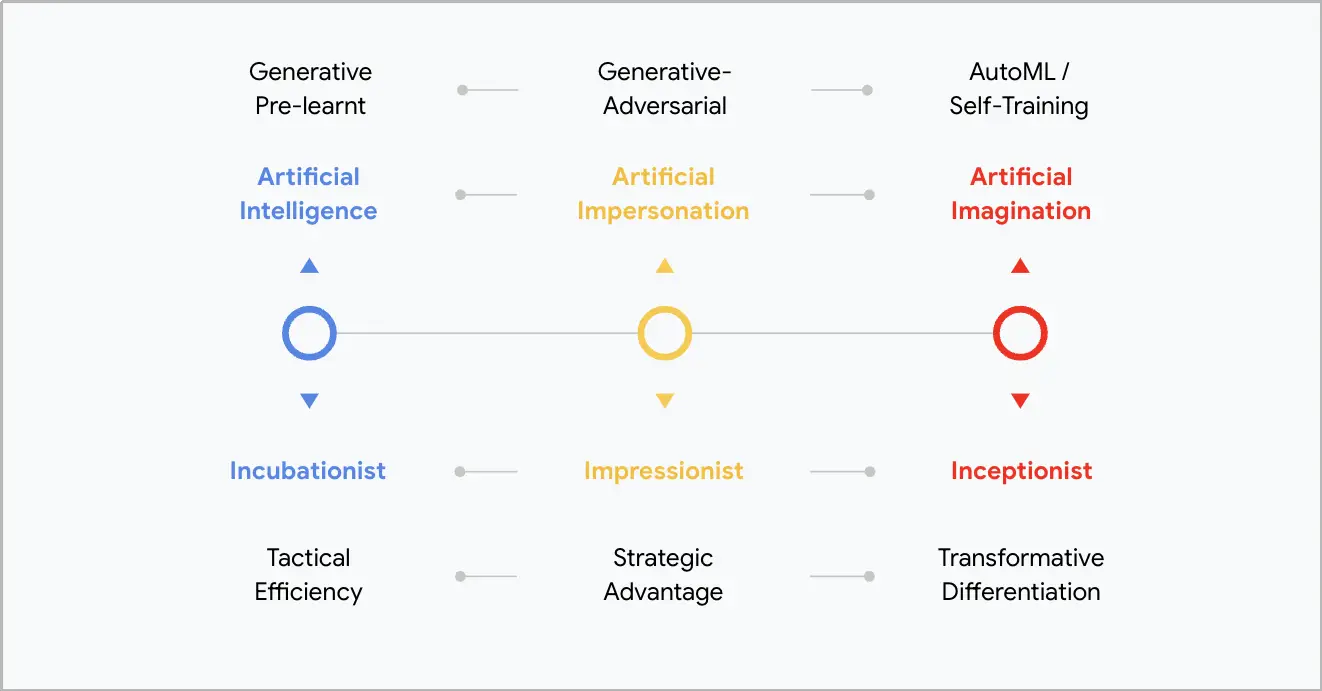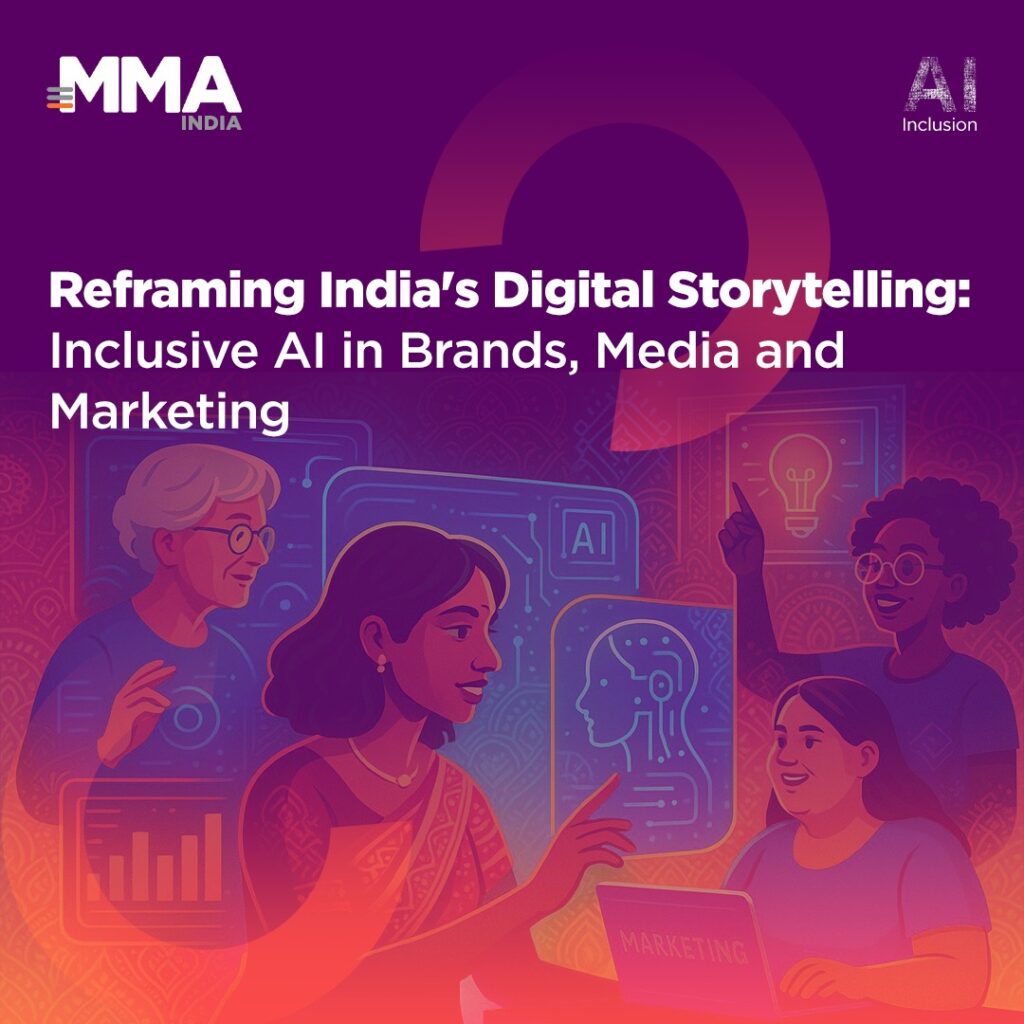
Artificial Intelligence’s (AI) evolution will be driven by advancements in learning and output methods expanding the capabilities from task-oriented efficiencies to strategic assets that provide a competitive advantage. Ultimately, AI will become transformative, capable of generating or capitalizing on differentiation. By 2030 80% of marketing will be AI augmented. On a CAGR basis between now and 2030, we are expecting to see predictive AI in the Ads market to grow 20% and the Gen AI market to grow 28% in APAC [1]. These projections outstrip global forecasts of 17% and 24% respectively. This is a result of various factors. Governments have been pushing hard for infrastructural development, there is great interest from private investors and there is an unbridled optimism among employees across APAC. All these factors are all helping drive adoption and experimentation across these parts of the world.
We are currently in the initial phase of AI’s potential to reshape modern marketing. In 2024, AI technologies will land. Today AI is powering (1) Customer connections to reach and engage your customers at scale where they watch, search and shop (2) Effective creatives: Optimizing creatives across different formats, surfaces, and supplement with additional features. (3) Durable measurement: We can rely on AI solutions for privacy-preserving technologies to measure results and uncover insights without 3P cookies [2]. You are not competing with AI, but rather, competing against other marketers empowered with AI.

Figure I: How AI Capabilities will evolve over time. Author’s personal point of view, Google Internal Data
73% of advertisers who moved from Exploring AI ad solutions to Adopting solutions across objectives realized a quantifiable business impact across multiple dimensions. Benefits cut across revenue generation, efficiency, productivity, customer experience, and creativity. Here we can see the impact for a subset of these AI powered ad solutions for example proof points. And businesses who are the AI Leaders when it comes to AI powered ad solutions saw an even greater impact than Adopters. The double-digit conversion improvements that come from Value-Based Bidding is one of the most powerful proof points to bring real business goals and AI ads together for impact [3].
|
How ready are you for AI?
To evaluate and encourage advertisers’ adoption of AI-powered advertising solutions we have developed a scorecard approach to track the depth and breadth of how you are adopting AI Ads solution. The score helps benchmark against industry and region peers based on their relative adoption of AI-powered ad solutions across various Marketing Objectives. The scorecard is not only a reflection of where we are, but what’s possible next.
Structure of the Score
- The Google AI Ads Adoption Score is a numerical score calculated by evaluating an advertiser’s usage of Google AI solutions across various marketing objectives.
- The score is not based on a binary, all-or-nothing assessment of whether a specific AI product is being used. Instead, the score considers the depth and breadth of AI product adoption. For example, the score might consider the percentage of ad spend allocated to campaigns using a certain AI feature.
- The score considers factors such as Awareness & Consideration, Online Sales, Apps, Measurement, and Applied AI (custom AI solutions built using Cloud technology).
- The score considers the advertiser’s adoption of the AI solutions that are most relevant to their stated objectives. For instance, under the MO “Awareness & Consideration,” the score takes into account the advertiser’s usage of Video Reach Campaigns and Demand Gen Campaigns.
- Awareness: AI optimized video campaigns for Reach or Views
- Consideration: Demand Gen campaigns to drive consideration/mid funnel
- Online sales: Lower funnel solutions to help drive online conversions
- Apps: App Campaigns to drive conversions on APPs (Installs, engagement etc)
- Measurement: Durable measurement solutions while preserving user privacy
AI Ads Adoption Score by Industry Vertical across markets
- Travel, Retail, Online Classifieds have the highest adoption across markets.
- In Indonesia, Media & Entertainment, Telecom, Travel, CPG and Finance advertisers are more advanced amongst Southeast Asia on average adoption of AI ad solutions.
- Overall the AI ads adoption is highest in Singapore and Malaysia followed by Indonesia and Thailand.
| Vertical / Market | ID | MY | PH | SG | TH | VN | Overall SEAS |
| Auto | 24% | 35% | 28% | 27% | |||
| Classifieds | 37% | 34% | 30% | 33% | |||
| CPG | 15% | 23% | 12% | 5% | 15% | 6% | 14% |
| Diversified | 13% | 13% | |||||
| Finance | 24% | 28% | 33% | 19% | 24% | 11% | 22% |
| Gaming | 28% | 0% | 7% | ||||
| Government | 11% | 11% | |||||
| Health | 11% | 9% | 12% | 25% | 20% | 18% | 16% |
| Industrial | 21% | 21% | |||||
| M&E | 34% | 24% | 18% | 32% | 12% | 17% | |
| Real estate | 17% | 17% | |||||
| Retail | 44% | 22% | 44% | 37% | 21% | 35% | |
| Tech | 20% | 16% | 24% | 20% | 19% | 5% | 18% |
| Telecom | 36% | 38% | 36% | 19% | 7% | 26% | |
| Travel | 46% | 44% | 68% | 25% | 37% | 35% | |
| Overall Market | 24% | 28% | 21% | 25% | 23% | 11% | 21% |
Table I: AI Ads Adoption Score by Industry Vertical across markets, Google Internal Data
AI Ads Adoption Score by Marketing Funnel Objective
- We see Travel, Retail, Online Classifieds across Southeast Asia markets adopt AI ad solutions ahead of other verticals across the funnel.
- Auto, Telecom, B2B advertisers use AI ad solutions more for driving meaningful engagements like driving intentful marketing visits and leads.
- CPG advertisers across focus on Reach and Views efficiency and have scope to use AI solutions to build relevance with users.
| Adoption Area by Vertical | Awareness & Consideration | Reach & Views | Demand Generation | Online Sales | User Intent
Coverage |
Value Based Bidding | Privacy Safe Conversions Tracking | Apps Aggregate | Diversified App Ads | Web 2 App Connection |
| Auto | 55% | 57% | 53% | 26% | 58% | 1% | 28% | 1% | 1% | 0% |
| Classifieds | 54% | 46% | 61% | 32% | 49% | 22% | 31% | 14% | 7% | 21% |
| CPG | 36% | 48% | 24% | 12% | 14% | 7% | 2% | 0% | 0% | 0% |
| Diversified | 50% | 50% | 50% | 0% | 0% | 0% | 0% | 0% | 0% | 0% |
| Finance | 40% | 41% | 39% | 24% | 44% | 8% | 12% | 7% | 9% | 4% |
| Gaming | 11% | 22% | 0% | 8% | 14% | 7% | 5% | 0% | 0% | 0% |
| Government | 34% | 15% | 54% | 6% | 9% | 0% | 0% | 0% | 0% | 0% |
| Health | 38% | 45% | 31% | 15% | 27% | 0% | 2% | 0% | 0% | 0% |
| Industrial | 50% | 0% | 100% | 22% | 8% | 58% | 0% | 0% | 0% | 0% |
| M&E | 34% | 34% | 33% | 16% | 25% | 1% | 12% | 6% | 7% | 4% |
| Real estate | 36% | 39% | 33% | 8% | 21% | 0% | 38% | 0% | 0% | 0% |
| Retail | 45% | 43% | 47% | 41% | 42% | 43% | 27% | 21% | 7% | 36% |
| Tech | 33% | 23% | 43% | 17% | 18% | 14% | 21% | 1% | 1% | 1% |
| Telecom | 63% | 51% | 75% | 18% | 27% | 0% | 16% | 7% | 11% | 3% |
| Travel | 42% | 47% | 37% | 30% | 37% | 41% | 27% | 39% | 33% | 44% |
| Overall | 40% | 42% | 37% | 20% | 29% | 13% | 14% | 7% | 6% | 9% |
Table II: AI Ads Adoption Score by Marketing Funnel Objective, Google Internal Data
AI Ads Adoption Progress by Industry Vertical across markets
- Since the beginning of 2024 till Aug 2024, AI ads adoption progressed +3% points across Southeast Asia with Philippines (Finance and Telco) and Thailand (CPG and Tech) advertisers progressing most rapidly.
- In Indonesia, we saw Media & Entertainment advertisers adoption scores jump +13% and also Telco and Travel advertisers move more keenly on leveraging AI powered efficiencies.
Based on the data insights, here are the AI ad solutions advertisers should strongly consider for the future:
- Value-Based Bidding (VBB): The significant conversion improvements achieved through VBB makes this solution align AI ad optimization with real business goals, making it a crucial tool for maximizing ROI.
- Industry-Specific AI Solutions:
- Travel, Retail, Online Classifieds: These industries are already ahead in AI adoption. Advertisers in these verticals should continue to explore advanced AI solutions to maintain their competitive edge.
- Auto, Telecom, B2B: These advertisers should prioritize AI solutions for driving meaningful engagements like intentful marketing visits and leads.
- CPG: CPG advertisers should consider expanding their AI usage beyond reach and views to focus on building relevance with users and driving conversions.
- Custom AI Solutions (Applied AI): For businesses with the resources and expertise, consider developing custom AI solutions using Cloud technology to address specific marketing challenges and unlock further differentiation.
Additional Recommendations:
- Focus on Experiment and Measure
- Stay Abreast of AI Advancements: AI is evolving rapidly. Advertisers need to stay informed about the latest AI technologies and trends to identify new opportunities and stay ahead of the competition.
- Experiment and Learn: Don’t be afraid to experiment with different AI ad solutions to discover what works best for your business. Use data-driven insights to continuously refine your strategies.
- Partner with Google: Google’s AI Ads Adoption Score can help benchmark your progress and identify areas for improvement. Collaborate with Google to leverage their expertise and resources in AI advertising.
Advertisers who embrace predictive AI solutions for their media today are the ones who will Fast Track to Marketing Success tomorrow.
______________________________________________________________________
The Modern Marketing Reckoner 2024 Report is a comprehensive resource to empower industry leaders with forward-looking strategies and scalable business solutions for 2025, leveraging new technologies and adapting to evolving consumer trends to reach ultimate business goals. By embracing the strategies and recommendations outlined in this report, companies can set themselves apart in a competitive market and lead with vision and agility.
This report is enriched with relevant Indonesian data, insights, and an outlook on marketing and advertising, as it addresses the profound impact of digitization and the evolving digital economy, guiding the industry leaders to navigate and succeed in an ever-changing digital landscape.
Download MMA Indonesia Modern Marketing Reckoner 2024.
Sources:
[1] Statista, Report: Artificial Intelligence WorldWide Chart Title Market Size and Market Size Generative Artificial Intelligence Jan 2024
[2] Ibid
[3] Google Internal Data



















